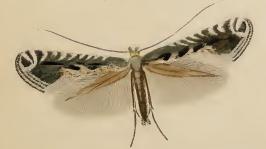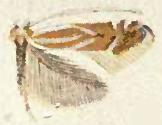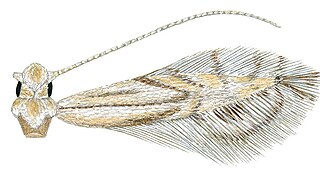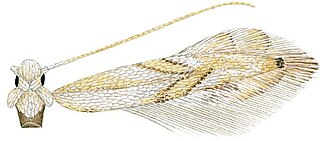
Amorpha is a genus of plants in the pea family, Fabaceae. All the species are native to North America, from southern Canada, most of the United States (US), and northern Mexico. They are commonly known as false indigo. The name Amorpha means "deformed" or "without form" in Greek and was given because flowers of this genus only have one petal, unlike the usual "pea-shaped" flowers of the Faboideae subfamily. Amorpha is missing the wing and keel petals.

Gracillariidae is an important family of insects in the order Lepidoptera and the principal family of leaf miners that includes several economic, horticultural or recently invasive pest species such as the horse-chestnut leaf miner, Cameraria ohridella.

Amorpha fruticosa is a species of flowering plant in the legume family Fabaceae, known by several common names, including desert false indigo, false indigo-bush, and bastard indigobush. It is native to North America.

Macrosaccus robiniella is a moth of the family Gracillariidae.

Parornix anglicella is a moth of the family Gracillariidae found in Asia and Europe. It was described in 1850, by the English entomologist Henry Tibbats Stainton, from a specimen from Lewisham, Kent.

Parornix torquillella is a moth of the family Gracillariidae found in Europe. The larvae mine the leaves of Prunus species, such as blackthorn. It was described by the German entomologist Philipp Christoph Zeller in 1850, from specimens found in Florence, Leghorn and Pisa.
Macarostola japonica is a species of moth of the family Gracillariidae. It is native to Japan.
Eumetriochroa miyatai is a moth of the family Gracillariidae. It is known from the islands of Hokkaidō, Honshū, Shikoku and Kyūshū in Japan.
Ketapangia leucochorda is a moth of the family Gracillariidae. It is known from India, Japan and Kiribati.
Ketapangia regulifera is a moth of the family Gracillariidae. It is known from Japan, Malaysia, the Philippines (Luzon) and Taiwan.
Chrysaster hagicola is a moth of the family Gracillariidae. It is known from Japan, Korea and the Russian Far East.

Phyllonorycter albanotella is a moth of the family Gracillariidae. It is known from Ontario and Québec in Canada and Illinois, Kentucky, Ohio, Texas, Maine, Vermont and Connecticut in the United States.

Phyllonorycter basistrigella is a moth of the family Gracillariidae. It is known from Québec in Canada and Connecticut, Illinois, Oregon, Kentucky, Maine, Michigan, New York, Vermont, Pennsylvania, Colorado, Massachusetts, Rhode Island, California and Missouri in the United States.
Cameraria sadlerianella is a moth of the family Gracillariidae. It is known from California and Oregon in the United States.
Cameraria walsinghami is a moth of the family Gracillariidae. It is known from California, United States.

Phyllocnistis subpersea is a moth of the family Gracillariidae. It is found in the Dade and Monroe Counties of Florida. Mines of what appear to be this species have been found as far north as the Green Swamp in coastal South Carolina.

Phyllocnistis longipalpa is a moth of the family Gracillariidae. It is known only from the Everglades National Park, Dade County, and along the Loop Road near Tamarind Hammock, Monroe County, Florida.

Phyllocnistis perseafolia is a moth of the family Gracillariidae. It is known only from the type locality in the Department of Caldas, west-central Colombia, but probably widespread over northern South America wherever avocado is cultivated.

Macrosaccus gliricidius is a moth of the family Gracillariidae. It is known from Central America and the West Indies.

Filatima pseudacaciella, the dusky-backed filatima moth, is a moth of the family Gelechiidae. It is found in North America, where it has been recorded from California, Illinois, Indiana, Kansas, Kentucky, Louisiana, Maine, Massachusetts, Mississippi, New Hampshire, New York, Ohio, Oklahoma, Ontario, Tennessee and West Virginia.








